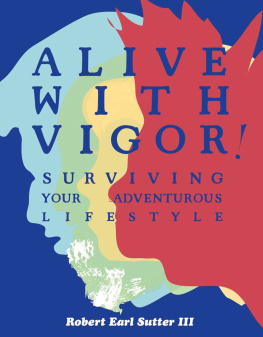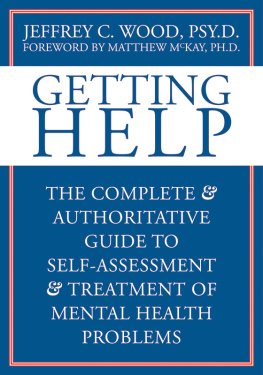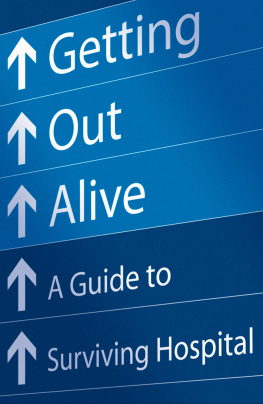
Alive with Vigor
Robert Earl Sutter III
ISBN 9781934620472
First Published February 15, 2014
Microcosm Publishing
636 SE 11th Ave
Portland, OR 97214
All work remains property of the original author
Designed and Edited by Joe Biel
Line Edited by Lauren Hage
Distributed by IPG

TABLE OF CONTENTS
Introduction
Robert Earl Sutter III

Everything we do and dont do contributes to our health and to the health of everyone around us. Were all interconnected in a way that sometimes seems terribly complicated, but sometimes incredibly simple: if we go on a drinking binge for three days, wreck our immune system, and catch the flu, we should not be surprised. Note to self: take it easy!
What is healthy for one person may not be healthy for another. Priorities can be different with our different bodies and you may find contradictions in this book! We are not pretending to know what is best for everyone, only to share our experiences. Sometimes you need to hear others stories to realize what is going on with yourself. Reading these accounts can be helpful as you reflect on your own.
Not everyone has the same access to health care, money, a supportive network of friends and family, and privilege. Some of this advice might not be appropriate or possible for you, but the stories can inspire your own self-care, community care, and spark conversations with others about ways to be healthy.
The recent death of Elyse Mary Stern, someone close in our community here in Minneapolis, while riding her bicycle has made me reconsider the delicate hold on life that we have. I considered my own behavior, like cycling on our city streets, and made a choice to be more cautious and aware. I looked at my clunker of a bike: bad brakes, skipping drive train, no lights. I counted my money. What good would that money do if I was killed because my bicycle failed at a crucial moment? I broke open the piggy bank and got a decent ride: two working brakes, a good drive train, perfect wheels, and a front and back light for night riding. Im cautious at every intersection and attempt to be mindful all the time while riding. When riding a bike or driving a car, it is essential to our survival to pay great attention to what we are doing when we are doing it. If youre out drinking and somebody offers you a chance to sleep it off before going home, please take the offer. No drunk driving.
Sometimes the thing to consider is how our injury, harm, or death would affect those close to us, even if we are terribly depressed or having a hard time and ceasing to care. Sometimes rebuilding your close relationships and having a heart-to-heart about your problems can provide those reasons to live that were escaping you or had gone forgotten. Sometimes seeing how much you mean to other people happens because of a trauma, tragedy, or a diagnosis and it can bring your community closer together.
Everyone in this book is a survivor of their experiences and there is much to learn. I hope this book will inspire conversations about health so we can continue learning from each other, and to live with vigor!
DEALING WITH EMOTIONS
Will Meek PhD

When I was a younger dude, there were only two emotions I could deal with, joy and anger. Any other feelings I had about myself, my relationships, or the world around me either became those two, or left me a confused and miserable mess. Any type of emotional pain was overwhelming, and by the time I was 17, I made a deal with myself to eliminate all emotions from my life. By focusing on logic and reason at all times, I could avoid the rollercoaster of emotions that I was prone to.
After a few months I actually got pretty good at this. I could carefully analyze any situation that generated the slightest bit of feeling, and maintained a reasonable equilibrium most of the time. Unfortunately, there was a dark side. I started to become detached from the most important people in my life, and generally started to lose motivation for things I previously loved.
What I did was find a way to circumvent something that makes us all human. Emotions are signals about what is happening in our lives, and they also help us form healthy attachments, stay motivated, plan for the future, show that we are hurting, and avoid danger. Eliminating that stuff made my life feel flat and meaningless.
A few years later I made some radical changes to embrace my feelings, and figure out how to ride their occasionally terrifying waves, and corral their power when I needed to stay in control. I also became a psychologist that focuses on emotions, and have been working to help other people manage their feelings better than I did.
If you are someone who has some issues dealing with your feelings, whether they be anger, anxiety, depression, grief, excitement, lust, or anything else, there are a few things you should know. These five steps are based on brain research and backed up by real life experience, and they were key for me learning to deal with my feelings too. To make the most of this, next time you are having a strong emotion, go through each step in order, which should help you have a deeper understanding of what is happening, and what to do next.
1. Sensing
The building blocks of emotions are in the physical sensations and automatic impulses we experience. So the first step in dealing with your emotions is to scan your body and specifically identify the types of sensations and motivations you are having. Is your stomach turning? Is your jaw clenched? Is there a lump in your throat? Is your face flush? Do you want to throw something through a wall? One mistake people make is skipping over this step entirely, which leaves us out of tune with our body. Another is when we deny that the sensations exist, or assume them to be something other than part of an emotional experience, like saying Im just tired.
2. Naming
Once you have the feelings down, it is important to accurately name the emotion. The mistakes people make here are mislabeling it, or using generic words that do not get it exactly right. For example, using words like weird, upset, or bothered all have a variety of meanings. There is more power and ability to work with the emotion when using words like anxious, sad, or angry instead. Additionally, we often have blends of several emotions at a time, or conflicting emotions, which makes this part even more difficult. Having a good emotional vocabulary is an important part of this, so look below for a list of emotion words.
3. Attributing
After you have the right emotion, it is key to accurately determine what caused it. Sometimes this is obvious, whereas other times emotions seem to come out of nowhere or for no reason. Emotions are almost always triggered by something, but the triggers may be unknown to us. A common explanation for emotions coming out of nowhere is that the emotion was present, but was only consciously experienced when there was space for it, like when doing a mindless task, or laying down at night to sleep. A mistake people make in this step is attributing the emotion exclusively to one thing. For example, say a person that just had an argument, and then became enraged in traffic. In this step, wed say that the anger was immediately provoked by the traffic, but the strength of the emotion is likely due to the earlier argument.
Next page











